The third instalment in Mario Matassa’s new series uncovering the secrets of Italian food involves a trip to the deli counter to discover exactly why cured meats are so cherished by the Italian nation
Photos by Mario Matassa
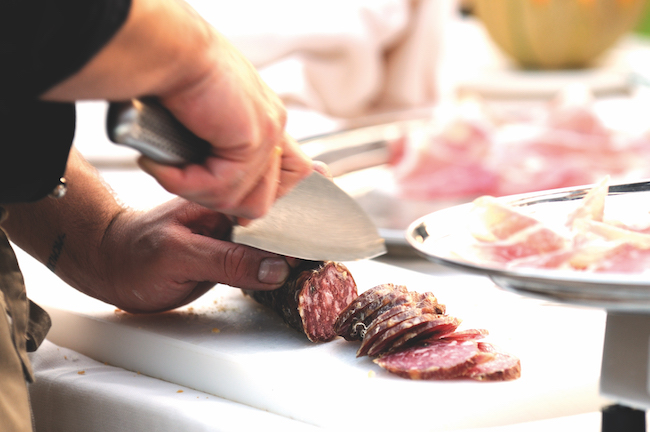
Years back, driving through customs, it was common practice for Italian immigrants returning from their annual summer visit to the home country to discreetly conceal half a dozen salumi under the blankets of sleeping children in the back seat of the car. The risk of confiscation and a fine was deemed acceptable. Even today, for most Italians living abroad, the dream of a canopy of ageing salumi hanging from the rafters in the cantina can be just that: a dream.
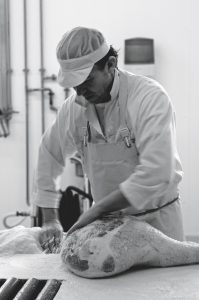 Salume (pl. salumi) is the generic name for all salted and cured meat products. They’re officially made in a salumificio and sold in a salumeria. (Unofficially they’re made in a neighbour’s kitchen.) But salume isn’t just salami and Parma ham. There are over 600 different types of salume and 100 types of cured ham produced the length of the peninsula. Which is the best depends ultimately on questions of taste, climate, quality of ingredients, means of production and provincial loyalty – the latter being akin to supporting your local football team. (For me, it’s my neighbour’s.) My point is that when Italians discuss the subject of salume (a surprisingly popular topic of conversation) they can be talking about, among others, cured ham (prosciutto crudo), coppa, pancetta, guanciale, lardo, culatello, speck, mortadella, bresaola and capocollo… And, within each type, there is a seemingly infinite variety.
Salume (pl. salumi) is the generic name for all salted and cured meat products. They’re officially made in a salumificio and sold in a salumeria. (Unofficially they’re made in a neighbour’s kitchen.) But salume isn’t just salami and Parma ham. There are over 600 different types of salume and 100 types of cured ham produced the length of the peninsula. Which is the best depends ultimately on questions of taste, climate, quality of ingredients, means of production and provincial loyalty – the latter being akin to supporting your local football team. (For me, it’s my neighbour’s.) My point is that when Italians discuss the subject of salume (a surprisingly popular topic of conversation) they can be talking about, among others, cured ham (prosciutto crudo), coppa, pancetta, guanciale, lardo, culatello, speck, mortadella, bresaola and capocollo… And, within each type, there is a seemingly infinite variety.
The key point is that each salume is unique; just as no two wines are the same, so too with salumi. If you consider prosciutto crudo, it’s safe to say that almost everyone has heard of Parma ham, many will be familiar with San Daniele, fewer with the Norcia hams of Umbria. Yet these are just three out of a hundred different hams made in Italy. They’re not necessarily the best, just the most successfully branded and exported.
Understanding your salumi is about understanding territory. A complex  combination of factors – which includes microclimate (humidity, temperature, air), breed, territory, ingredients, tradition and method – is integral to making a good salume. It seems odd, but it’s true nonetheless, that a good Parma ham can be made in the hills around Langhirano (the capitale del prosciutto) yet travel just 20 kilometres down the road to Zibello and you won’t find a producer for love nor money. However, detach the pear-shaped muscle from the middle of the same ham and the locals produce culatello – considered by many to be the king of cured meats.
combination of factors – which includes microclimate (humidity, temperature, air), breed, territory, ingredients, tradition and method – is integral to making a good salume. It seems odd, but it’s true nonetheless, that a good Parma ham can be made in the hills around Langhirano (the capitale del prosciutto) yet travel just 20 kilometres down the road to Zibello and you won’t find a producer for love nor money. However, detach the pear-shaped muscle from the middle of the same ham and the locals produce culatello – considered by many to be the king of cured meats.
But, understandably, if you can’t quite make it to Langhirano or San Daniele del Friuli for ham, or Zibello for culatello, where do you buy your salume? To make a point, every year about 10 million hams in Parma are branded with the 5-point crown signifying DOP status and origin. Of these, less than one-fifth are exported. Interestingly, however, millions of pre-sliced packets of ham are sold, three-quarters of them abroad. The point is, Italians do eat a lot of salume, but they prefer it fresh.
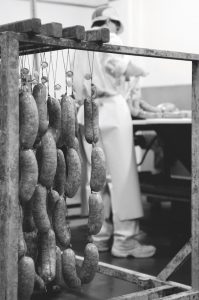 There’s always a queue at deli counters in Italy. Buying your daily ration of affettato (mixed cured meats) is akin to the daily visit to the bakery. Cured meats are sliced fresh and purchased by the etto (100g), then consumed within a few hours – either at lunch or dinner. So, if you want to get the best of what’s on offer, buy it fresh, buy what you need and eat immediately (or at least, when you get home).
There’s always a queue at deli counters in Italy. Buying your daily ration of affettato (mixed cured meats) is akin to the daily visit to the bakery. Cured meats are sliced fresh and purchased by the etto (100g), then consumed within a few hours – either at lunch or dinner. So, if you want to get the best of what’s on offer, buy it fresh, buy what you need and eat immediately (or at least, when you get home).
However, if you happen to be just visiting Italy, a whole different set of rules apply. The first rule of thumb is to eat local: don’t order Parma ham in Gaiole in Chianti, eat the local ham. And don’t order bresaola in Calabria, go for the local cured sausage. Local (nostrano) salume are not only characteristic of the territory, but will better complement both the local cuisine and wine.
And, finally, what about something to take home? This brings us back to the collection of salumi under the back seat of the car. My advice is don’t always look for the obvious. The best guide to buying salumi will invariably be found in the local bar – ask around. Local artisan producers sell direct and it’s here that you are most likely to find something truly unique.
And now for a few personal suggestions on how to make the most of your salume in the kitchen…
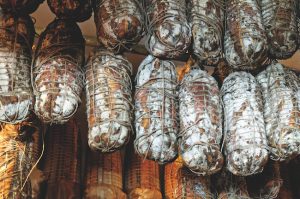 Speck
Speck
Speck (IGP) is a speciality of Alto Adige. The ham is marinated for a couple of weeks in an aromatic brine which includes pepper, garlic, nutmeg and juniper. It is then dried and slowly cold-smoked (at a temperature less than 20°C), after which it is hung for between four and five months. It has a robust and intense flavour, and because it is both salt-cured and smoked, it is one of the more versatile of Italian salumi. That is to say, it can be enjoyed naturally, in its own right, like Parma ham, or it can withstand the rigours of the kitchen and be cooked. Speck works particularly well with soft cheeses and these two recipes – cooked and uncooked – will help to demonstrate its versatility.
Click here or here for Mario’s delicious speck recipes.
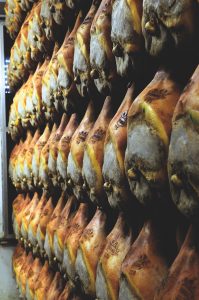 Parma ham
Parma ham
Many Italians, myself included, have misgivings about cooking with prosciutto crudo. The only exception that I can personally think of that I find acceptable is saltimbocca alla romana – although for that dish I wouldn’t use Parma ham specifically, but another crudo (arguably one from Lazio). One Italian food writer wrote that using Parma ham as an ingredient is a “crime against its personality”. I agree. Fresh Parma ham is subtle, delicate in flavour, and melts in the mouth. Once cooked – apart from the fact that it becomes cooked ham – it loses its fragrance and character, the texture is transformed, and it becomes slightly salty. It’s no coincidence that despite Italian culinary ingenuity, the best we’ve been able to come up with when it comes to Parma ham is to serve it draped over melon or figs or with a few curls of unsalted butter. They’re the perfect accompaniment and why, after all, would you want to tamper with perfection?
However, if you want to try something different, there are options. A good ham does not like to be accompanied by excessive acidity. Therefore, do not serve it with acidic vegetables – never with tomatoes. Sweet and sour vegetables, cooked in a little vinegar and preserved in oil, are perfect. Porcini mushrooms work well with Parma ham, as do artichokes with Tuscan hams. For the following recipe, try to find a good-quality sweet orange.
Mario shares his Parma ham recipe here.
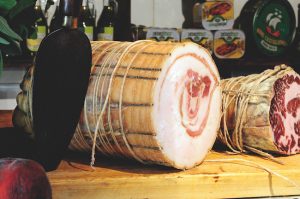 Pancetta
Pancetta
Of all the salumi, it is pancetta that Italians cook with most often. Pancetta can come in many forms – smoked, unsmoked, rolled or flat. It is made from the belly of the pig and it is the closest that the Italians get to bacon. Practically every region of Italy makes some form of pancetta. Here in Piacenza, the pancetta has achieved
DOP status and is regarded as one of the best of its kind. The meat is simply seasoned by hand, rolled and hung to dry for a couple of months. The local microclimate is left to do the rest.
Although it might look like bacon, Italians generally don’t fry it in the pan and eat it between two slices of bread or with eggs – although in moments of nostalgia I have to admit that I have done so myself. Usually it’s either eaten raw, in an affettato as an antipasto, or it is cooked with other ingredients. This recipe, bucatini all’amatriciana, is a classic and it’s one of the few where a particular type of pasta has become known by the sauce. The dish comes from Amatrice (in Lazio) and its history is disputed. Some puritans will argue that the dish must be made using guanciale (cured pork cheek), but I have found that pancetta is a more than acceptable substitute.
Mario’s recipe for pancetta is here.
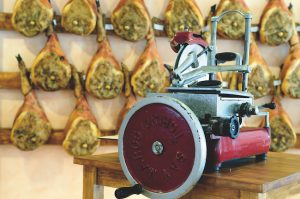 Lardo
Lardo
Lardo is not to be confused with lard. The two most famous examples are Lardo di Colonnata (Tuscan) and Lardo di’Arnad (Valle d’Aosta). Lardo di Colonnata (IGP) is made in the small community of Colonnata, close to Carrara in Tuscany. The pork fat is layered in white marble troughs (or coffins) with a mixture of salt and seasonings, which include rosemary, garlic, nutmeg, cinnamon and cloves, and it is ready to eat after six months. Due to both the porous nature of the marble and the microclimate of the underground caves, no preservatives are added to the fat. Lardo d’Arnad (DOP) pigs were traditionally fed on chestnuts. Again, the fat is layered in a brine of salt and other seasonings, but this type of lardo is aged for up to a year.
You can cook with lardo, and I often do. However, if you manage to get hold of one of the more prized lardo (such as either of the above or Lardo di Montefeltro in Le Marche) it is arguably best enjoyed thinly sliced and eaten as a delicacy. I was served the dish on the left in a restaurant in Cogne in Valle d’Aosta, and the combination of chestnuts, honey and rye bread with lardo somehow captures the taste and sense of territory, for which all good salumi are famous.
Mario’s lardo recipe can be found here.
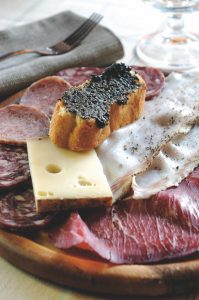 Affettato misto
Affettato misto
The affettato misto (mixed cured meats) is the classic Italian antipasto. It is served in practically every restaurant in Italy. It requires no preparation other than a trip to the deli plus the time it takes to unwrap your salume. However, this does not mean that it’s a thoughtless exercise. In fact, serving a good affettato is an art in itself.
There are no hard and fast rules, but a few guiding principles do help. The first is to keep things simple and to try to keep within the regions. If I am at home in Emilia-Romagna, I will always make a local affettato – three slices of prosciutto crudo, three slices of coppa, two slices of pancetta, two slices of local salami, and served with either bread or chisolini (small squares of deep-fried bread dough) and a small serving of gardiniera (sweet and sour vegetables).
In the recipe below, however, I was in the mountains and opted for a more rugged version – as, in fact, availability of ingredients dictated. I used two slices of lardo, three slices of bresaola, two slices each of traditional pork salami, wild boar salami and a cooked salami. I served it with a crostini topped with black truffle paste and a thick slice of nostrano semi-stagionata (local medium-matured cheese). I can’t be more specific about the cheese as it’s nostrano and that’s all they will tell you at the deli counter. We’ll come to this later on in the series.
Click here for Mario’s speck and robiolo bites recipe.
Don’t miss part 1 and part 2 of Mario’s Vero Italiano series.
